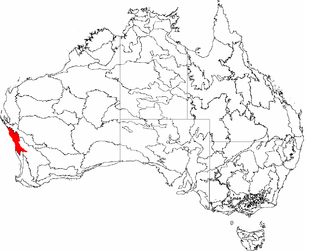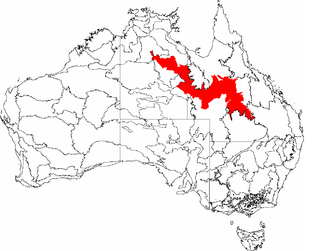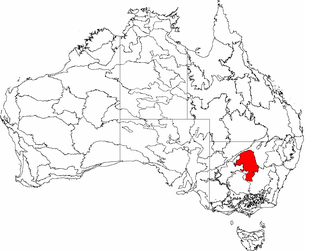
The Central Kimberley, an interim Australian bioregion, is located in the central Kimberley region of Western Australia, comprising an area of 7,675,587 hectares.

Geraldton Sandplains is an interim Australian bioregion of Western Australia. It has an area of 3,142,149 hectares. The Geraldton Sandplains is part of the larger Southwest Australia savanna ecoregion, as assessed by the World Wildlife Fund.

The Victoria Bonaparte, an interim Australian bioregion, is located in the Northern Territory and Western Australia, comprising 7,301,242 hectares.

Yalgoo is an interim Australian bioregion located in Western Australia. It has an area of 5,087,577 hectares. The bioregion, together with the Avon Wheatbelt and Geraldton Sandplains bioregions, is part of the larger Southwest Australia savanna ecoregion as classified by the World Wildlife Fund.

Dampierland is an interim Australian bioregion in Western Australia. The region is also a distinct physiographic section of the larger Nullagine Platform province, which in turn is part of the larger West Australian Shield division.

New South Wales North Coast or NSW North Coast, an interim Australian bioregion, is located in New South Wales, comprising 3,996,591 hectares.

The Mitchell Grass Downs (MGD) is an IBRA biogeographic region, located in the Northern Territory and Queensland, which comprises an area of 33,468,761 hectares with eight subregions.

The Pine Creek biogeographic region, an interim Australian bioregion, is located in the Northern Territory, and comprises 2,851,777 hectares.

The Gulf Coastal, an interim Australian bioregion, is located in the Northern Territory, comprising 2,711,718 hectares.

The Gulf Fall and Uplands, an interim Australian bioregion, is located in the Northern Territory and Queensland, comprising 11,847,909 hectares.

The Gulf Plains, an interim Australian bioregion (IBRA), is located in the Northern Territory and Queensland, comprising 22,041,825 hectares. It is one of 89 such bioregions defined in Australia, with 419 subregions as of IBRA version 7, compared with the 85 bioregions and 403 subregions described in IBRA6.1.

Burt Plain, an interim Australian bioregion, is located in the Northern Territory, and comprises 7,379,719 hectares.

The Simpson Strzelecki Dunefields, an interim Australian bioregion, comprises 27,984,283 hectares, and is part of four state/territories of Australia: the Northern Territory, South Australia, New South Wales and Queensland

Mount Isa Inlier, an interim Australian bioregion, is located in the Queensland, and comprises 6,778,263 hectares.
The Pacific Subtropical Islands is an interim Australian bioregion which includes Norfolk Island and Lord Howe Island. Its IBRA code is PSI.

Central Mackay Coast, an interim Australian bioregion, is located in Queensland, and comprises 1,464,208 hectares.

Cobar Peneplain, an interim Australian bioregion, is located in New South Wales, and comprises 7,385,346 hectares.

Finke, an interim Australian bioregion, comprises 7,267,416 hectares, and is part of two state/territories of Australia: the Northern Territory and South Australia. It is part of the Central Ranges xeric scrub ecoregion.

Stony Plains, an interim Australian bioregion, comprises 13,166,372 hectares, and is part of two state/territories of Australia: the Northern Territory and South Australia.

Tanami is an interim Australian bioregion, comprising 25,997,277 hectares in the Northern Territory and Western Australia. It is part of the Great Sandy-Tanami desert ecoregion.



















